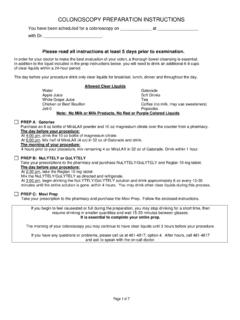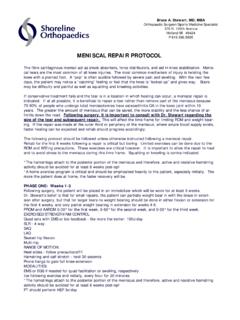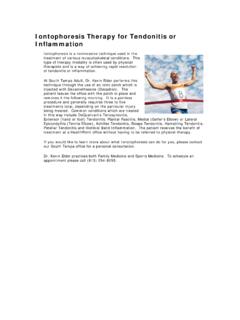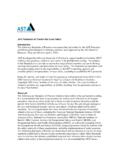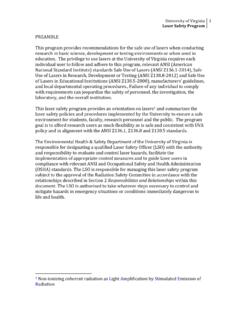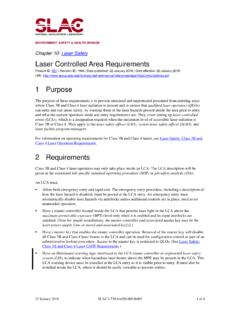Transcription of DIABETIC RETINOPATHY PANRETINAL …
1 1 DIABETIC RETINOPATHY PANRETINAL PHOTOCOAGULATION (PRP) ERIC S. MANN, , Ph. D. The DIABETIC RETINOPATHY Study (DRS) established PANRETINAL photocoagulation (PRP) laser treatment as the treatment standard for proliferative RETINOPATHY with high risk characteristics to prevent severe visual loss. High risk characteristics are the ocular findings in DIABETIC eyes with the greatest potential with PRP laser treatment. PRP laser treatment lessens the chance of severe visual loss and provides a much higher chance of visual preservation. PRP arrests the progression of PDR by causing new vessels to regress.
2 PRP is not preformed to improve guarantee stabilization of PDR. In spite of PRP, progression of PDR may proceed with neovascularization, bleeding and/or preretinal fibrosis with retinal detachment and visual loss. The following are common side effects of laser treatment: 1. glare and light sensitivity 2. ocular irritation 3. decreased peripheral vision with narrowed visual field 4. inflammation 5. decreased central vision from worsening macular edema 6. decreased accommodation 7. decreased dark adaptation The following are uncommon complication of laser treatment: 1. choroidal neovascularization 2.
3 Retinal breaks or detachments 3. hemorrhage 4. acute intraocular pressure rise(glaucoma) 5. corneal abrasion 6. cataract Other less common complications may be discussed as well. These uncommon complications may result in loss of vision, loss of globe or need for further laser treatment or intraocular surgery. PANRETINAL cryo is an alternative therapy to PRP laser treatment for PDR. Post-treatment activity restrictions may include sleeping with the head of the bed elevated and eyedrops may be recommended to minimize intraocular inflammation. If retrobulbar anesthesia is used the eye will be patched for 12 to 24 hours.
4 2 DIABETIC RETINOPATHY Eric S. Mann , DIABETIC RETINOPATHY occurs in 25% of the DIABETIC population and is the leading cause of blindness in the United States between the ages of 20 and 64. Visual loss in DIABETIC RETINOPATHY occurs from leakage of fluid from retinal vessels (non-proliferative DIABETIC (NPDR), and abnormal growth of new vessels (proliferative DIABETIC RETINOPATHY (PDR) which bleed or form scar tissue on the surface of the retina. In addition, poor blood supply to the macula (reading center) or optic nerve can result in the loss of vision. Moderate visual loss may occur as a consequence of macula edema (thickening of the retina within the reading center secondary to DIABETIC -induced retinal vascular leakage of fluid).))
5 Severe visual loss may occur as a consequence of bleeding of abnormal new vessels on the optic disc or elsewhere on the surface of the retina into the vitreous gel (vitreous hemorrhage). In addition, new blood vessels may form scar tissue on the surface of the retina (preretinal fibrosis) which may lead to a tractional retinal detachment of the reading center (macula). laser photocoagulation, cryotherapy, and/or intraocular surgery (vitrectomy) may be recommended to attempt to arrest the progression of DIABETIC RETINOPATHY and prevent both moderate and severe visual loss. 3 PERIBULBAR & RETROBULBAR ANESTHESIA Absence of pain (anesthesia) and immobilization of the eye (akinesia) are often necessary to allow effective laser and cryotherapy treatment or intraocular surgery.
6 Both anesthesia and akinesia can be obtained to a variable degree by injection of anesthetic (Lidocaine and/or Marcaine) around and behind the eyeball prior to treatment or surgery. The following are common effects of the anesthetic injection but are usually temporary: 1. Blurring of vision 2. Numbness and swelling around the eye 3. Ptosis (drooping of the eyelid) 4. Diplopia (double vision) The following are uncommon complications of the anesthetic injection: 1. Retrobulbar or periorbital hemorrhage (bleeding behind or around the eyeball) 2. Globe perforation (puncture of the eyeball by the needle used for anesthetic injection) 3.
7 Optic nerve injury or vascular damage (central retinal artery or vein occlusion) 4. Allergic reaction to the anesthetic 5. Seizure 6. Cardiorespiratory arrest (death) 7. Bilateral akinesia These uncommon complications may result in permanent loss of vision, need for further surgery or treatment, or loss of the globe. Other less common complications may be discussed as well. Post treatment care may include applying ointment to the eye and wearing a patch for 24 hours. 4 INFORMED CONSENT I, _____ have been given the brochure(s) on DIABETIC RETINOPATHY , PANRETINAL photocoagulation and Peribulbar & Retrobulbar Anesthesia.
8 I have had the opportunity to read, understand and ask questions regarding this procedure(s). Dr. Mann has explained this procedure to me in depth. I have been informed in regard to the potential benefits, complications, risks and alternatives of the procedure. Sufficient time was allowed for me to ask questions and these questions were answered to my satisfaction. _____ _____ Patient signature date _____ _____ Witness signature time 5 PROCEDURE NOTE PATIENT: _____SS# _____ DATE: _____ SURGEON: DR.
9 ERIC MANN PROCEDURE: PRP _____ INDICATIONS: (67228) PROLIFERATIVE DIABETIC RETINOPATHY_____ VA: OD _____ OS _____ VITALS Pre-op Post-op BP _____ _____ P _____ _____ R _____ _____ INFORMED CONSENT: All the risks, benefits, alternatives and intent of laser treatment with anesthesia were presented to the patient in an extensive discussion and in written form(s) attached. The patient understood that laser treatment is performed not to improve vision, but to hopefully stabilize vision and prevent further visual loss.
10 The patient stated that he/she had a good understanding of his/her clinical situation, including the specific ocular and anesthetic risks (loss of vision, need for further surgery, and rarely, loss of globe) and consented to laser treatment. TREATMENT: Under topical anesthesia Under retrobulbar anesthesia: with the patient supine and fixating straight ahead, 3 cc of 2% lidocaine were injected into the retrobulbar space, using a #25 guage needle and a 10 cc syringe. Adequate anesthesia and akinesia were obtained. Following treatment, the eye was patched for 24 hours.
